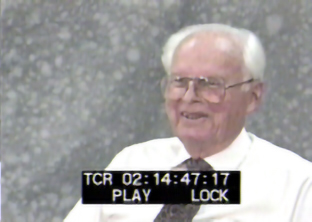The History of InfoAge Science & History Museums
Oral Histories - Oral History of Phil Petersen Interviewee: Phil Petersen
Interviewee: Phil Petersen
Interviewer: Michael Ruane
Date: 1998?
Place: Camp Evans – 9039
Media: NTSC Video
Summary: Mr. Irv Bauman
Phil Peterson authored a large number of amateur radio history stories – The Phil Petersen Collection.
PHIL PETERSEN Avionics Laboratory
Phil began his Ft.Monmouth service on Nov 17, 1941, (just before Pearl Harbor) hired because of his amateur radio experience. He was Bernie Ricciardi’s supervisor. He suggested that Bernie get his Amateur Radio License, completing whatever training would so qualify him. Phil learned early that thousands of amateur radio types worked with hands-on equipment at Ft. Monmouth. Phil lived in Staten Island before Pearl Harbor, and he used to speak to Ft. Monmouth Military personnel via radio frequently.
His Evans work included visits to contractor’s plants such as Bendix Radio. With Great Britain in the war against Germany, Ft. Monmouth was called upon to send materiel and equipment to Britain. Evans, Coles, Sandy Hook were all staffed with radio people to help with Signal development. Radar, at that time, was called Radio Position Finding. Phil was assigned to improve the quality of RDF. The result of that effort and a system called SCS were shipped to Britain and helped to turn the tide against Germany.
Phil’s group was involved in a device to scramble talk for all but intended listeners. In a fighter submarine “The Thrasher” antennas were installed for communication. On Thrasher, Phil observed a crowded radio room. Knowing of functional equipment producing the same outputs with a much smaller size, he offered to correspond with authorities, offering the smaller system. However, the operator stopped him since he felt that the con-fined space would only be filled with other bulky functional items to further crowd his already confined space. Phil dealt with many companies that cooperated wholeheartedly with his group. There was no “hanky panky” at top levels, all anxious to help the US to stay ahead of the arms race. Phil felt that many standard commercial airline equipments could be effectively used by the military and he identified and applied these to military needs. He recalls a visit by a Congressman asking why the use of commercially available equipment and was reminded that you don’t “reinvent the wheel”.
With regard to Senator McCarthy” hearings at Ft. Monmouth, Phil knew of several employees who were accused of radical leanings, without a valid reason. He felt that progress in Signal Development was hampered by these ridiculous accusations. Phil’s group worked along with a number of contractors to include R CA, Collins Radio, Wilson, Wilcox, Hughes Aircraft. He found dealing with top-level management very proper, with no “gravy” offers. He referred to Col John DeWitt, an early CO at Evans, and a radio operator who suggested placing Radars around the world to sense rocket approach. Later the “Bedspring” antenna was built, that contacted the moon. Phil defined “Amateur Radio Enthusiast” as one who never was paid for his radio work, but did so because of his motivated interest in radio communication. He identified Col. Blair, another earlier Director of the Laboratory, as the first to get a patent on early Radar. His son, Charles, also worked in the Laboratories.
Raytheon Corp “dressed up” the radar hardware to end up as a very useful item for the military. Phil pointed out that radar circuitry design led to a number of commercial developments, to include television
His interview was cut off after 31 min, 20 sec. of view time
Page created August 2, 2002
We Need Your Help! Volunteer with Us.
Join our mission to preserve historic Camp Evans and teach the public about science and history.
Sign up to join our team of volunteers and start on your own mission today.
InfoAge Science & History Museums
2201 Marconi Road
Wall, NJ 07719
Tel: 732-280-3000
info@infoage.org
webmaster@infoage.org
